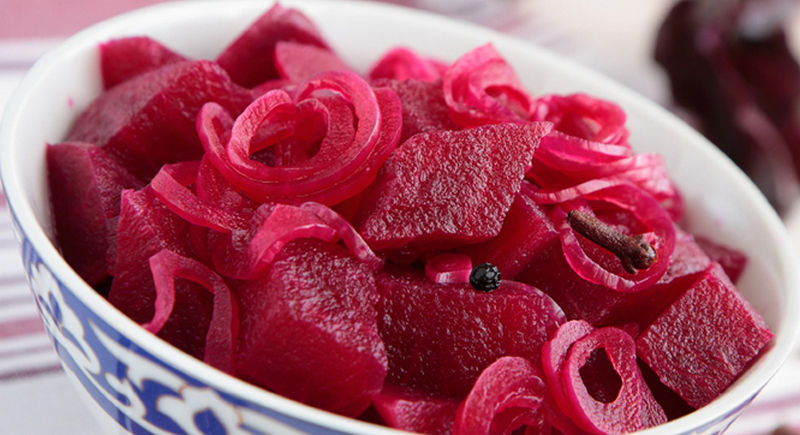If you are a fan of pickled veggies, I assume you have tried pickled beets or probably even made it on your own. Pickling is the best way to preserve some types of veggies like cucumber, okra, and beets.
Pickled is the term used to call food or veggies which are preserved through the pickling process. Pickling is actually an ancient or traditional way of preserving food and the method is very easy. The pickling process has different effects or induce different tastes on the food or veggie depending on the seasoning or ingredients added to it. As for pickled beets, you can enjoy its delicious tastes while preserving it for a long period of time.
Canning process can be somewhat different from the traditional pickling process but nowadays, commercially preserved, or pickled food are canned, bottled, or in jars.
Since pickled beets are already preserved for long-term, can you still freeze it? Can you keep pickled beets frozen and skip the canning procedure? Yes, you can. You can keep pickled beets frozen even without canning it. Just place the pickles in a freezer bag or food container, add the pickling mixture, and keep it in your freezer.
To understand the process of pickling and how to keep pickled beets frozen, we put together all the necessary information for you. Some tips are also included in this article so just keep reading.
A Guide to Pickled Beets – And How to Freeze Them
It is not difficult to make your own pickled beets at home and you do not need costly ingredients to prepare. All you need is to take time to do it because the pickling process can be a little time consuming.
Remember that beets has purple or deep red color. Its color can also stain clothes so you might want to use an apron to keep your clothes unstained while following the pickling process. The beet’s color can also stain your fingernails so you can also opt to put on your gloves before handling the veggies.
Since we noted that beets can stain, better use tools or kitchenware that is not susceptible to its stain or use those that is easy to clean to remove stain.
How Pickled Beets Are Made
Before letting you go to the storage or freezing process of pickled beets, it will help if you understand how beets are pickled because it is relevant to how you should be able store it properly.
The pickling process is a method of preserving food which can be fruits or vegetables. Nowadays, due to the advent of technology, pickling can be made faster with the help of machines and it is generally called canning typically because most preserved foods are packed or store in cans. However, if you will pickle some beets at home you can directly refrigerate or freeze them right after the pickling process.
In making pickled beets, you can choose from ingredients to preserve and sweeten them, or simply pickle the beets.
These are the ingredients to make sweetened pickled beets.
- Beets
- Sugar
- Ground cloves
- Cinnamon
- Vinegar
These are the ingredients to make pickled beets that is not sweet.
- Beets
- Vinegar
- Salt
- Sugar
- Bay leaves
- Peppercorns
Vinegar and sugar are the common ingredient on both the recipes. These ingredients have preservation effects on food. You can also add some more ingredients to your liking but remember that each ingredient you will add will affect the taste of the pickled beets.
These are the steps of the pickling process:
- Clean the beets thoroughly by scrubbing the dirt and rinsing it several times. Be sure to cut off the stems or tails of the beets.
- Place beets in a pot with lid. Be sure to submerge them in ample amount of water and boil it.
- When the water boils, lower the heat temperature. Keep the cover or the lid on and simmer it for not more than 45 minutes.
- Allow the beets to cool down while rinsing it in tap water.
- Rub the skin of the beets to peel it off or use a peeler to remove the skins.
- Slice or cut beets to your preferred size and put them in a big bowl.
- Prepare the ingredients for pickling. Put the vinegar and sugar in a saucepan and mix it.
- Boil the mixture for about 5 minutes, then turn off the heat.
- Add your choice of seasonings to the mixture and mix thoroughly.
- Pour the mixture onto the sliced beets. Cover the bowl or container and refrigerate.
- Let it chill for a few days, but the beets usually absorb the mixture within 24 hours. Stir it at least once daily.

After pickling the beets, you may freeze it right away or can it. You can can the beets by placing it in a jar together with the brine. Then, water-bath the jar before putting it in your freezer. If you do not have the canning items at home, you can just freeze it in a food container together with the brine.
Freezing Pickled Beets
Do not fuss over how to freeze pickled beets because it is really easy. You can freeze it in a large freezer bag or portion the beets into separate containers with lid or several freezer bags. Whether it is a food container or a freezer bag, it has to be tightly sealed so that the brine will not leak into your freezer.
If you made too much pickling mixture or brine and you do not want to discard it right away, you can also keep it refrigerated in a separate container for later use. However, if you intend to freeze the beets, just let it soak in the brine for a day or more before freezing it, then you can discard the brine.
Steps on how to freeze pickled beets:
- Place the beets in a durable freezer bag or food container and put a few spoons of the pickling mixture. Be sure to leave an ample space on the bag or container, probably an inch or a half.
- Seal tightly and put labels with dates as reminder to its shelf-life.
- Keep it in your freezer for not more than 1 year.
If you tried pickling beets following the instructions in this article, you can prove that it is really easy to do. You can enjoy your pickled beets any time.
Using Frozen Pickled Beets
If we encouraged you that pickling beets is easy and simple, then using it after freezing is easier and simpler.
Take note that you pickled the beets because you the pickled beet flavor in a dish and you do not plan on adding them to a plain or fresh beet recipe.
These are the steps on how to use pickled beets after freezing them.
- Take the pickled beets from the freezer. If you want to cook it, jump to step 2. If you like to use cold or chilled pickled beets, go to step 3.
- Thaw the frozen beets while the fridge overnight. If it is frozen in a freezer bag, place the freezer bag in a big bowl so the water will not drip into your fridge when it thaws. Drain the beets and follow your cooking procedure.
- Thaw or defrost frozen beets while in the fridge for 8 hours or more. You can also leave it at room temperature for about 2 to 4 hours to thaw. Serve cold or chilled.
- Place the remaining pickled beets in a container and have it refrigerated. It is now ready anytime you want it.
- Remember that pickled beets can be best for consumption within two months even after thawing it, just keep it refrigerated.
Pickled beets will remain best and tasty for quite some time as long as properly stored and refrigerated. When it remained soak in the brine for a longer time, it becomes even more flavorful.
Related Questions
It is no doubt easy to make pickled beets as it is easy to freeze them. We will be glad to know that this articled helped you.
Here are some questions and answer that could give you more information.
Does vinegar make the beets unhealthy?
The process of pickling usually have vinegar as the main preservative and it also has its own health benefits. Vinegar does not make the beets lose it health benefits either. Pickled beets still have it protein content, and other vitamins and mineral. Beets are a great source of Vitamin C, Magnesium, Folate, Potassium, and Iron.
Can you pickle beets after they were frozen raw?
Definitely. After thawing the frozen raw beets, you can prepare them for pickling and simply follow the steps we stated in this article.
Can eating beets become unhealthy?
Any food should be taken in moderation to gain much from its healthy benefits. Anything taken excessively can cause mild to acute health problems. Beets have healthy benefits but when taken excessively can damage the kidney or cause calcium deficiency.

